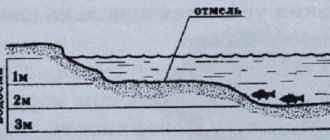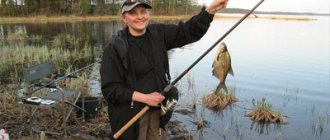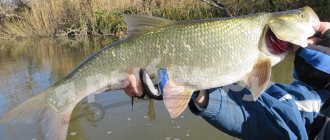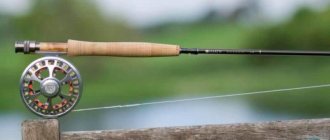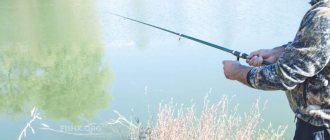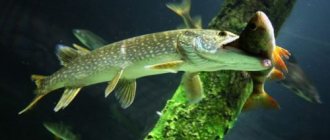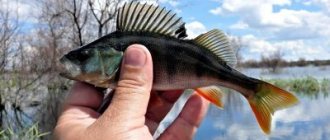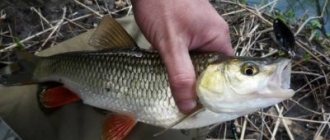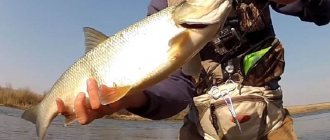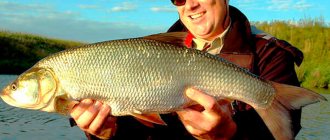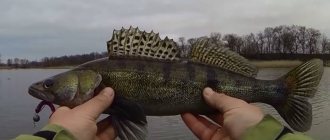Catching an asp with a spinning rod is an exciting activity, but catching an active predator, especially in the spring, is quite difficult. However, this does not scare spinning fishermen. After all, it is impossible to forget the powerful bites and landing of the river horse. You want to experience such experiences again and again. When going to a pond, it is important to familiarize yourself with the peculiarities of catching asp (sheresper) in the spring, and also take care of purchasing suitable gear.
Sheresper is a handsome and spirited opponent
Where to look for asp in spring on different bodies of water
The river horse (asp) can be found in small and large rivers. A representative of the carp family loves flow, not standing water.
On small rivers
In small bodies of water, the sheresper hunts alone, ambushing prey in snags and riffles. It is recommended to fish places where trees hang over the water.
Note! The fish moves along the river and hunts for fry, choosing the same route.
On medium and large rivers
In medium and large bodies of water, it is recommended to fish areas of rifts, shallow spits and snags. On riffles (shallow areas of the river bed) the current is quite strong. Holes form behind the crossbar. Promising places may be above/below the riffles. The predator can also stand at the top of the dumps.
Most often, the river horse pursues medium-sized forage fish, such as bleak or verkhovka. Periodically, the sheresper attacks its prey with violent blows and somersaults.
Typical Sheresper sites in spring
Peculiarities of asp behavior in spring
As the water warms up, the asp, gathering in flocks, moves more actively around the water area. But the flocks are not as numerous as in the summer. A pattern has been noticed that schools are formed according to the size of the fish. The smaller the asp, the larger the flock.
In the spring, the asp fish often waits for prey behind the rifts in the current or in areas with a reverse current. As soon as small fish enters its field of vision, the predator, using its high-speed capabilities, rushes after its prey.
After the water warms up above 8 degrees, the asp begins spawning. At the end of spawning, the predator is passive for about 2 weeks and practically does not feed. Then he begins to have a post-spawning glutton.
Fishing for asp in the spring using spinning rods is carried out taking into account the behavioral characteristics of the fish in each spring month.
Tackle
A spinning rod with a length of 2.4-2.7 m is perfect for catching sheresper. With such tackle, you can cast over long distances. The size of spinning reels should be in the range of 2500-3000. The inertia-free action allows you to easily cast small baits over long distances.
As the main line, it is permissible to use braided line, the thickness of which reaches 0.15 mm, or monofilament line (diameter 0.28 mm). Avid fishermen recommend making leashes from fluorocarbon.
Color of asp baits
Also, the asp is characterized by a peculiar habituation to the same bait. Therefore, if you notice that a predator has stopped responding to the bait that was previously effective, you should replace it. In this case, it is even better to change the direction of the wiring. The asp is a rather smart and cautious fish, so it is considered a very desirable trophy.
The best color option for asp bait is silver, the color of bleak. In clear weather, bluish baits with silver inserts on the sides also perform well.
On cloudy days with bad weather, a dark color in combination with the same silver on the sides of the bait becomes relevant.
Catching asp using a spinning rod
In order for asp fishing to be successful, before going fishing, you should familiarize yourself with the fishing characteristics of the lively predator. It is important to choose the most suitable fishing tactics and choose a catchable bait.
Features of fishing in early spring
When going in search of asp in early spring, you should first of all catch:
- reservoirs that do not freeze for the winter;
- water areas from which the ice has disappeared.
The highest catchability in March is observed in reservoirs that are not covered with ice. Due to the acceptable water temperature, the activity of the asp will be high. By fishing in waters from which the ice has already disappeared, the fisherman will be able to achieve a decent catch.
When going fishing for sheresper with a spinning rod in early spring, you can use the following baits:
- oscillating spoons;
- wobblers;
- rotating spoons.
A set of baits for sherespers.
At this time of year, a spinner with loading works well. The weighty bait allows you to cast as accurately as possible over long distances. The listed baits can be used for fishing in deep reservoirs with medium/fast currents.
Note! If you want to use dead live bait, you should give preference to small fish with an elongated body (bleak, gudgeon, etc.). The recommended size of the fish is 8-9 cm.
When fishing a reservoir in search of a lively predator in early spring, it is worth using uniform wiring, as well as:
- jig;
- twitching;
- stop and go.
When making long casts it is important to be precise. It is worth practicing in advance to thoroughly become familiar with the throwing technique.
Catching asp with a spinning rod in early spring from the shore in the 2021 season, where to look for the handsome sheresper and what baits to use - video from the river bank:
Features of fishing in April
In April, the sheresper can be found in areas of reservoirs saturated with oxygen, since the river horse is difficult to tolerate oxygen starvation. During this period, it is advisable to engage in fishing:
- sand spit;
- brow;
- stuck areas;
- yam.
Note! When the ice completely melts, the fish will move to steep areas that are located in the coastal zone. As soon as the water temperature begins to rise, the lively predator will begin to actively move along the river in search of prey.
When going on a quiet hunt in April, it is worth taking with you a class H spinning rod, the length of which is 3-3.3 meters. The recommended gear action is fast, the upper limit of the test reaches 30 grams. This rod is convenient for power casting and active retrieving.
It is better to use a spinning reel. The spool size should be 2500-3000. As the main line, it is permissible to use braided line, the cross-section of which reaches 0.16 mm, or monofilament line (diameter 0.3 mm). The leash is made of fluorocarbon. The use of metal leashes is advisable only in cases where pike live in the reservoir.
As the sheresper sees, the fisherman needs to position himself on the shore so as to be out of sight of the predator
The most catchy baits in April are:
- spinners;
- balancers;
- jigs - weighted oscillating spoons;
- Cone-shaped jigs with bleak or sprat attached to the hook.
Jigs are good for asp
Also in mid-spring, you can use wobblers and silicone baits to catch predators. Using Devon allows you to provoke a passive Sheresper into attacking. This is due to the fact that the rotating blades of the bait create vibrations that attract fish.
Advice! When fishing areas with aquatic vegetation, it is worth using a spinnerbait.
Free jigs on spinnerbaits - with such baits you can jig as with ordinary silicone; this option is even preferable if fishing is done in the middle of the water.
The most effective retrieve at this time of year is considered to be surface fishing. The bites of predatory fish are sharp and strong, so it is important not to be distracted while fishing.
Catching a large asp with a spinning rod in the spring from the shore on a small river, baits and secret retrieves - video from the shore:
Features of fishing in May
With the onset of May, the asp ceases to feel a constant feeling of hunger. During this period, it is best to come fishing early in the morning or in the evening (17-18 hours).
On some small and medium-sized rivers in May, sheresper can be caught well from 4 to 5:30 in the morning. Rifles are considered an ideal place for catching predators in late spring.
In shallow water the current begins to accelerate. Fish will increasingly appear near the shore, chasing prey. Due to the movement of water near the shore it becomes quite noisy. This will hide extraneous sound from casting tackle and not spook the river horse.
You can also catch asp in May in areas that are overgrown with aquatic vegetation. Also, do not avoid places near trees that have fallen into the water.
To fish for a predator at the end of spring, it is worth using a spinning rod, the length of which is 2.6-3.2 meters, and the test is 40 g. The action of the rod should be fast, medium-fast.
During this period, intensive wiring is used, so it is advisable to use a high-speed reel, the spool capacity of which reaches 100 meters. The recommended diameter of monofilament line is 0.3 mm. If you wish, you can use braided wire (0.14 mm).
When going asp fishing in May, you should take with you the most effective baits, which include:
- Spoons of elongated shape . The most catchy ones at this time of year are castmaster-type baits, the weight of which reaches 30 grams.
- Wobblers . For fishing for predators in May, sinking minnow models, the length of which reaches 50-70 mm, are suitable.
- Elongated jig baits . The color of the main part of the twister/vibrotail should be light, and the back should be dark.
Castmaster is the best at all times among spinners when fishing over long distances.
The bait is thrown to the expected location of the predatory fish, or 2-4 meters downstream from the battle site, after which vigorous retrieving is performed with short pauses.
Each stop should last only 1 s.
Asp baits
The asp is a rather cautious and whimsical fish, so you will never guess which bait the predator will take better on a certain day. In order, as they say, not to be left with your nose, it is better to grab an arsenal of different types of baits, among which it is desirable to have the following:
- castmaster;
- oscillating spoons;
- jig baits;
- wobblers;
- poppers.
Castmaster is the heavy and long-range spinner, which is considered one of the best baits for asp and brings good results in fishing not only in spring, but also in summer;
Oscillating spoons weighing from 30 g;
Bombarda (sbirulino), which is a large float that allows you to cast light baits further;
Live bait (small roach, bleak, top swimmer).
Surface wobblers are also worth trying, as wobblers are similar to bleak and float on the surface of the water. But it is difficult to throw a floating wobbler far, since it is quite light, and here you need to look at the situation. By the way, the Original Rapala wobbler has proven itself well.
However, the most spectacular and often quite effective spring asp hunting is fishing with stickbaits and poppers. Unlike other predators that wait for the water to warm up well in the spring, the asp begins to peck at these surface baits early. Already in April, you can safely go fishing, taking poppers and stickbaits with you.
Tips and secrets
Below you can read the advice of experienced fishermen who have been catching asp for many years and know the secrets and intricacies of hunting for a lively predator.
- Early morning is considered the best time to catch sheresper in the spring. On cloudy days you can fish the river throughout the day.
- If you are going to fish an unfamiliar body of water, the first thing you need to do is locate the feeding areas of the sheresper . Most often, the predator moves along one route.
- When fishing in a body of water with a strong current, it is worth feeding the bait with a raft . You can also go into the water upstream. This technique is especially effective when using floating wobblers. Compliance with this recommendation will allow you not to scare away a cautious predator and to work as efficiently as possible in hard-to-reach areas of the reservoir, the coastline of which is heavily overgrown with reeds.
- When fishing sections of the river from the bank, it is recommended to cast from behind cover . This will make it possible not to scare away a cautious predator.
- If there is no bite for a long time, you can try tying a long fluorocarbon leash . Quite often, the sheresper does not take the bait because he notices the braided line.
- When going asp fishing, you should take baits of different sizes with you . Predator preferences differ in different bodies of water, so you need to be well prepared so as not to be left without a catch.
To catch an asp, you should follow a number of recommendations.
Catching a sheresper in the spring is a fascinating and interesting process. Despite the fact that asp meat is difficult to classify as a delicacy, fishermen go to reservoirs in order to catch this predator and then nobly release it.
This predilection for the sheresper is explained by strong bites and the powerful persistence that the fish shows when playing. For fishing to be effective, it is important to familiarize yourself with the peculiarities of asp fishing. Let the chosen location, gear and experience endlessly open up new perspectives. No tail, no scales!
Camouflage - camouflage first and foremost
Believe it or not, but the asp of the fisherman sees. Moreover, if you are standing on the shore, then he will see you from 12 meters away. And if you go into the water up to your chest, then only from 4 meters. But getting into spring water is fraught with all sorts of diseases, so you need to camouflage yourself on the shore. Do not wear bright clothes when going fishing - not only the asp, but also other fish are wary of bright colors. The ideal thing would be camouflage or something dark, with which you can pretend to be a tree (from the point of view of the fish, of course). And it’s best to catch an asp while sitting quietly on the shore, and not running along the entire coastline ———- The best fishing time for catching an asp is when the spring flood reaches its peak and floods the coastal shallow water, and a rapid stream flows along the river bed, bright in April The sun will warm the water more and more every day, awakening the river to life. Pay attention to shallow water with flooded willow bushes, to pits below the rifts, half-bays with flooded steep banks, to banks with trees that have fallen into the water, sand spits at the upper and lower ends of the islands, that is, to those places where the current slows down. These areas attract small fish, and this is where the asp waits for them. He is in a hurry to restore strength after winter and is particularly aggressive during this period.
Features of spinning fishing
Spinners will have the best chance of catching an asp in the spring. Thanks to well-assembled gear, you can make long and accurate casts of artificial baits. It is important not only to properly equip the spinning rod, but also to select a catchable bait.
Spinning rod equipment
All elements of a spinning rod must be selected so that the angler sees the weakest bites and can emerge victorious in the fight against trophy prey.
- To cast from the shore over a long distance, a rod of 2.7-3.0 m is required. The test indicator should be in the range of 50-70 g, since heavy baits will be required for fishing in deep areas.
- The choice of reel is limited to inertialess models. A spool size of 2000-2500 is suitable, but it is more important to wind the cord around it to the brim. Then, when casting, the bait will easily release the line from the reel.
- It is better to equip a spinning rod with braided fishing line, which has a breaking force of about 5 kg. Then there will be no problems with landing a large sheresper.
- A metal leash is usually not installed, since the river corsair does not have sharp teeth. A swivel with a snap hook is mounted at the end of the braid for easy replacement of the bait.
Spinning lures
In spinning asp fishing, the lion's share of success depends on the successful choice of bait. Guessing the preferences of a corsair can be difficult even for experienced anglers. That is why the box should contain a rich arsenal of spinners and silicone fish.
- In early spring, jig baits help catch predators that live in the depths. Twisters and vibrating tails equipped with weight heads are capable of reaching any depth. Combinations of metal spinners and silicone fish are interesting.
- Castmasters, popular among spinning players, are also capable of reaching deep asps. The streamlined shape and heavy weight make this bait a leader in terms of flight range.
- The unusual Devon spinner is of particular interest to the river corsair. It has good flight characteristics and also creates powerful vibrations when flying.
- Spreaders have proven themselves well when fishing for spring asp. The weight indicators of the spinners are in the range of 20-50 g.
- For spring fishing for sheresper, deep-sea wobblers can be used. During the retrieve, the bait should go close to the bottom, periodically touching it.
- To cast light spoons and wobblers, anglers use a bombard. This is a heavy float that flies far, carrying small baits with it.
Where to catch asp in May
To catch an asp, you must first exclude places where its appearance is impossible. In a body of water where there is no current, spinning fishing will not bring the desired result. Excessively exposed areas should be avoided. The asp is a shy fish, and its organs of vision are an excellent sensor that can detect a fisherman on the shore. Read also: Recipe for making asp balyk
The ideal place to catch asp in May is the rifts. In shallow sections of rivers, the current accelerates, which is especially attractive to the predator, which prefers to actively pursue its prey. In addition, the movement of water in such areas creates quite a lot of noise to mask extraneous sounds from casting spinning gear.
Another favorite place on the river is areas overgrown with aquatic vegetation. Good results can be achieved if you throw a spoon or wobbler near a tree that has fallen into the river. Despite the fact that in such places there is a high probability of getting caught, the chances of catching a large asp increase many times over.
In the evening and early morning, asp feeding areas can be detected by the characteristic strokes of the tail on the water. If a fight is noticed, then you should definitely throw bait to this place in order to become the owner of a trophy specimen. If the reservoir is too large, then you can detect the feeding areas of the asp by watching the seagulls circling above the water. This is interesting: Fishing in May on the Don, on Buzan, Fishing in the Tula region: Upa and Oka, in the Kostroma region.
If no battle sites were found, this does not mean that there are no fish in the reservoir. The asp can feed for a long time only from the bottom and not rise into the water column, but if you have a spinning rod and appropriate bait, it can be caught in this case too.
Fishing tactics
Catching asp in the spring has its own characteristics, without knowledge of which you are unlikely to get a good catch.
One of the fundamental success factors here will be camouflage. The asp is very careful; any unnecessary movement on the shore will scare him away.
Having decided on a place, they begin fishing. An important feature is that after casting you should immediately begin reeling, preventing the bait from sinking closer to the bottom. In this case, you can try fishing with a raft, letting the wobbler swim past a promising place, with the expectation that it will interest the predator.
Or wait until the asp indicates its presence with a characteristic blow, and then throw the bait towards it.
If you fish with live bait, then in this case it will move where it needs to.
Keep in mind that the asp is a predator who is extremely good at hiding. For example, in the morning and evening he can hide in the shade of trees, preparing to attack. And in the daytime, in bright light, go to the depths.
Adding excitement to such fishing is the ability of the asp to stun the fish or chase it by jumping out of the water.
A bite from an asp looks like a sharp feeling of something heavy hanging on the tackle. At this moment, hooking should be done, although most often the asp is hooked on its own. He resists quite stubbornly, trying with all his might to free himself from the bait, periodically trying to go to depth.
When and how to catch asp in spring
The best results come from catching asp during a fight, which is noticeable by fairly strong splashes on the surface.
When a promising place is found, you need to wait for the asp to splash on the surface of the water and cast, but a little further than the point where the splash was noticed. The calmer and quieter the bait falls into the water, the better.
When the bait is in the water, make a pull, and then return the rod to its original position. Most often, it is at this stage that the asp bite occurs.
Tackle for May asp: spinning rod, reel, fishing line
If the asp behaves cautiously until the moment of attacking its prey, then after the throw it actively pursues the prey and always hooks itself. Feeling in danger, he makes powerful jerks, trying to free himself. In order for the tackle to withstand such an onslaught, it is necessary to carefully select every detail of the spinning equipment. For this type of asp fishing, it is recommended to use:
- Rod.
The size and other characteristics of this part may differ significantly depending on whether fishing will be done from the shore or from a boat. To catch asp from the shore, you need to choose a rod with a length of 3.2 meters, a test weight of 40 g and a medium action. For fishing from a watercraft, you can use a blank of shorter length (2.2 - 2.4), and given the fact that when using a boat you can do without long casts, the action of the stick can be super-fast. Choosing a rod for twitching, jigging, ultralight.
- Coil.
The wiring is quite intense, so the reel must be high-speed, with a spool capacity of at least 100 meters, with a line diameter of up to 0.40 mm. Look at decent reels on Ali.
- Fishing line.
It is better to use monofilament fishing line with a diameter of 0.25 - 0.40 mm. A high-quality braided line is also suitable for fishing with a diameter of 0.14 mm.
Selecting a spinning rod for asp fishing video
Don’t know what kind of spinning rod and reel you need for an asp? The author of the channel “Simple Fishing” talks in detail from A to Z about all the little things and nuances of selecting the appropriate gear. Very useful material. Part one, below is part two about baits!
All of the listed elements of the spinning rod must be of high quality so that during sudden jerks of the fish their integrity is maintained when fighting a strong predator. For successful fishing, you will also need to choose bait that will be to the taste of the local predator.
